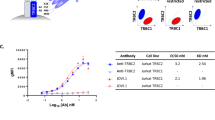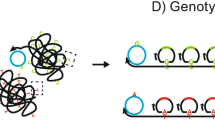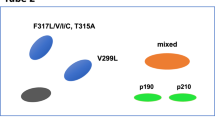Abstract
BCR–ABL fusion proteins show increased signaling through their ABL tyrosine kinase domain, which can be blocked by specific inhibitors, thereby providing effective treatment. This makes detection of BCR–ABL aberrations of utmost importance for diagnosis, classification and treatment of leukemia patients. BCR–ABL aberrations are currently detected by karyotyping, fluorescence in situ hybridization (FISH) or PCR techniques, which are time consuming and require specialized facilities. We developed a simple flow cytometric immunobead assay for detection of BCR–ABL fusion proteins in cell lysates, using a bead-bound anti-BCR catching antibody and a fluorochrome-conjugated anti-ABL detection antibody. We noticed protein stability problems in lysates caused by proteases from mature myeloid cells. This problem could largely be solved by adding protease inhibitors in several steps of the immunobead assay. Testing of 145 patient samples showed fully concordant results between the BCR–ABL immunobead assay and reverse transcriptase PCR of fusion gene transcripts. Dilution experiments with BCR–ABL positive cell lines revealed sensitivities of at least 1%. We conclude that the BCR–ABL immunobead assay detects all types of BCR–ABL proteins in leukemic cells with high specificity and sensitivity. The assay does not need specialized laboratory facilities other than a flow cytometer, provides results within ∼4 h, and can be run in parallel to routine immunophenotyping.
This is a preview of subscription content, access via your institution
Access options
Subscribe to this journal
Receive 12 print issues and online access
$259.00 per year
only $21.58 per issue
Buy this article
- Purchase on Springer Link
- Instant access to full article PDF
Prices may be subject to local taxes which are calculated during checkout









Similar content being viewed by others
References
Mitelman F, Johansson B, Mertens F . The impact of translocations and gene fusions on cancer causation. Nat Rev Cancer 2007; 7: 233–245.
Rowley JD . Chromosomal translocations: revisited yet again. Blood 2008; 112: 2183–2189.
Nowell P, Hungerford D . A minute chromosome in human chronic granulocytic leukemia. Science 1960; 132: 1497.
Rowley JD . A new consistent chromosomal abnormality in chronic myelogenous leukaemia identified by quinacrine fluorescence and Giemsa staining. Nature 1973; 243: 290–293.
de Klein A, van Kessel AG, Grosveld G, Bartram CR, Hagemeijer A, Bootsma D et al. A cellular oncogene is translocated to the Philadelphia chromosome in chronic myelocytic leukaemia. Nature 1982; 300: 765–767.
Bartram CR, de Klein A, Hagemeijer A, van Agthoven T, Geurts van Kessel A, Bootsma D et al. Translocation of c-ab1 oncogene correlates with the presence of a Philadelphia chromosome in chronic myelocytic leukaemia. Nature 1983; 306: 277–280.
Groffen J, Stephenson JR, Heisterkamp N, de Klein A, Bartram CR, Grosveld G . Philadelphia chromosomal breakpoints are clustered within a limited region, bcr, on chromosome 22. Cell 1984; 36: 93–99.
Konopka JB, Watanabe SM, Witte ON . An alteration of the human c-abl protein in K562 leukemia cells unmasks associated tyrosine kinase activity. Cell 1984; 37: 1035–1042.
Ben-Neriah Y, Daley GQ, Mes-Masson AM, Witte ON, Baltimore D . The chronic myelogenous leukemia-specific P210 protein is the product of the bcr/abl hybrid gene. Science 1986; 233: 212–214.
Hermans A, Heisterkamp N, von Linden M, van Baal S, Meijer D, van der Plas D et al. Unique fusion of bcr and c-abl genes in Philadelphia chromosome positive acute lymphoblastic leukemia. Cell 1987; 51: 33–40.
Hermans A, Gow J, Selleri L, von Lindern M, Hagemeijer A, Wiedemann LM et al. bcr-abl oncogene activation in Philadelphia chromosome-positive acute lymphoblastic leukemia. 1988; 2: 628–633.
Pane F, Frigeri F, Sindona M, Luciano L, Ferrara F, Cimino R et al. Neutrophilic-chronic myeloid leukemia: a distinct disease with a specific molecular marker (BCR/ABL with C3/A2 junction). Blood 1996; 88: 2410–2414.
Melo JV . The diversity of BCR-ABL fusion proteins and their relationship to leukemia phenotype. Blood 1996; 88: 2375–2384.
Gleissner B, Gokbuget N, Bartram CR, Janssen B, Rieder H, Janssen JW et al. Leading prognostic relevance of the BCR-ABL translocation in adult acute B-lineage lymphoblastic leukemia: a prospective study of the German Multicenter Trial Group and confirmed polymerase chain reaction analysis. Blood 2002; 99: 1536–1543.
Haskovec C, Ponzetto C, Polak J, Maritano D, Zemanova Z, Serra A et al. P230 BCR/ABL protein may be associated with an acute leukaemia phenotype. Br J Haematol 1998; 103: 1104–1108.
Boeckx N, Jansen MW, Haskovec C, Vandenberghe P, van der Velden VH, van Dongen JJ . Identification of e19a2 BCR-ABL fusions (mu-BCR breakpoints) at the DNA level by ligation-mediated PCR. Leukemia 2005; 19: 1292–1295.
Hochhaus A, Reiter A, Skladny H, Melo JV, Sick C, Berger U et al. A novel BCR-ABL fusion gene (e6a2) in a patient with Philadelphia chromosome-negative chronic myelogenous leukemia. Blood 1996; 88: 2236–2240.
Demehri S, Paschka P, Schultheis B, Lange T, Koizumi T, Sugimoto T et al. e8a2 BCR-ABL: more frequent than other atypical BCR-ABL variants? Leukemia 2005; 19: 681–684.
van der Velden VH, Beverloo HB, Hoogeveen PG, Zwaan Ch M . A novel BCR-ABL fusion transcript (e18a2) in a child with chronic myeloid leukemia. Leukemia 2007; 21: 833–835.
Deininger MW, Goldman JM, Melo JV . The molecular biology of chronic myeloid leukemia. Blood 2000; 96: 3343–3356.
Anastasiadou E, Schwaller J . Role of constitutively activated protein tyrosine kinases in malignant myeloproliferative disorders: an update. Curr Opin Hematol 2003; 10: 40–48.
Druker BJ, Talpaz M, Resta DJ, Peng B, Buchdunger E, Ford JM et al. Efficacy and safety of a specific inhibitor of the BCR-ABL tyrosine kinase in chronic myeloid leukemia. N Engl J Med 2001; 344: 1031–1037.
Schiffer CA . BCR-ABL tyrosine kinase inhibitors for chronic myelogenous leukemia. N Engl J Med 2007; 357: 258–265.
Weisberg E, Manley PW, Cowan-Jacob SW, Hochhaus A, Griffin JD . Second generation inhibitors of BCR-ABL for the treatment of imatinib-resistant chronic myeloid leukaemia. Nat Rev Cancer 2007; 7: 345–356.
Van der Burg M, Poulsen TS, Hunger SP, Beverloo HB, Smit EM, Vang-Nielsen K et al. Split-signal FISH for detection of chromosome aberrations in acute lymphoblastic leukemia. Leukemia 2004; 18: 895–908.
Van Dongen JJM, Macintyre EA, Gabert JA, Delabesse E, Rossi V, Saglio G et al. Standardized RT-PCR analysis of fusion gene transcripts from chromosome aberrations in acute leukemia for detection of minimal residual disease. Report of the BIOMED-1 concerted action: investigation of minimal residual disease in acute leukemia. Leukemia 1999; 13: 1901–1928.
Gabert J, Beillard E, Van der Velden VHJ, Bi W, Grimwade D, Pallisgaard N et al. Standardization and quality control studies of ‘real-time’ quantitative reverse transcriptase polymerase chain reaction of fusion gene transcripts for residual disease detection in leukemia—a Europe Against Cancer program. Leukemia 2003; 17: 2318–2357.
Van Denderen J, Hermans A, Meeuwsen T, Troelstra C, Zegers N, Boersma W et al. Antibody recognition of the tumor-specific bcr-abl joining region in chronic myeloid leukemia. J Exp Med 1989; 169: 87–98.
van Denderen J, van der Plas D, Meeuwsen T, Zegers N, Boersma W, Grosveld G et al. Immunologic characterization of the tumor-specific bcr-abl junction in Philadelphia chromosome-positive acute lymphoblastic leukemia. Blood 1990; 76: 136–141.
van Denderen J, ten Hacken P, Berendes P, Zegers N, Boersma W, Grosveld G et al. Antibody recognition of the tumor-specific b3-a2 junction of bcr-abl chimeric proteins in Philadelphia-chromosome-positive leukemias. Leukemia 1992; 6: 1107–1112.
van Denderen J, ten Hacken P, Berendes P, Zegers N, Boersma W, Grosveld G et al. Recognition of the ALL-specific BCR-ABL junction in P190bcr-abl by monoclonal antibody ER-FP1. Leukemia 1994; 8: 1503–1509.
Berendes PB, Veenman JN, Van Denderen AC, Van Ewijk W . Recognition of tumor-specific gene products in cancer (Fusion protein dipstick patent). International Patent 1998, (PCT/NL98/00289).
Berendes PB, Veenman JN, Van Denderen AC, Van Ewijk W . The BCR-ABL dipstick assay: a simple and rapid method for detecting Ph+ leukemias. In: Berendes P (ed). Recognition of Tumor-Specific Proteins in Human Cancer. PhD Thesis. Department of Immunology, Erasmus University Rotterdam: Rotterdam, The Netherlands, 1997, pp 111–127.
Van Dongen JJM, Van der Velden VHJ, Berendes PB, Van Denderen AC . Recognition of tumour-specific gene products in cancer (Fusion protein bead patent). International Patent 2001, (PCT/NL01/00.945).
Wada H, Mizutani S, Nishimura J, Usuki Y, Kohsaki M, Komai M et al. Establishment and molecular characterization of a novel leukemic cell line with Philadelphia chromosome expressing p230 BCR/ABL fusion protein. Cancer Res 1995; 55: 3192–3196.
Guo JQ, Wang JY, Arlinghaus RB . Detection of BCR-ABL proteins in blood cells of benign phase chronic myelogenous leukemia patients. Cancer Res 1991; 51: 3048–3051.
Beillard E, Pallisgaard N, van der Velden VH, Bi W, Dee R, van der Schoot E et al. Evaluation of candidate control genes for diagnosis and residual disease detection in leukemic patients using ‘real-time’ quantitative reverse-transcriptase polymerase chain reaction (RQ-PCR)—a Europe against cancer program. Leukemia 2003; 17: 2474–2486.
Pui CH, Robison LL, Look AT . Acute lymphoblastic leukaemia. Lancet 2008; 371: 1030–1043.
Wiedow O, Meyer-Hoffert U . Neutrophil serine proteases: potential key regulators of cell signalling during inflammation. J Intern Med 2005; 257: 319–328.
Maianski NA, Geissler J, Srinivasula SM, Alnemri ES, Roos D, Kuijpers TW . Functional characterization of mitochondria in neutrophils: a role restricted to apoptosis. Cell Death Differ 2004; 11: 143–153.
McWhirter JR, Wang JY . Activation of tyrosinase kinase and microfilament-binding functions of c-abl by bcr sequences in bcr/abl fusion proteins. Mol Cell Biol 1991; 11: 1553–1565.
Barnes DJ, Melo JV . Cytogenetic and molecular genetic aspects of chronic myeloid leukaemia. Acta Haematol 2002; 108: 180–202.
Primo D, Sanchez ML, Espinosa AB, Tabernero MD, Rasillo A, Sayagues JM et al. Lineage involvement in chronic myeloid leukaemia: comparison between MBCR/ABL and mBCR/ABL cases. Br J Haematol 2006; 132: 736–739.
Hamilton A, Elrick L, Myssina S, Copland M, Jorgensen H, Melo JV et al. BCR-ABL activity and its response to drugs can be determined in CD34+ CML stem cells by CrkL phosphorylation status using flow cytometry. Leukemia 2006; 20: 1035–1039.
Szczepañski T, Orfao A, van der Velden VHJ, San Miguel JF, van Dongen JJM . Minimal residual disease in leukaemia patients. Lancet Oncol 2001; 2: 409–417.
Acknowledgements
We thank Dr Jean Luc Sanne of the European Commission for his support in initiating and monitoring the EuroFlow project. We are grateful to Dr Frans Nauwelaers, Dr Alice Ho, Dr Charlene Bush-Donovan, Dr Rudi Varro, Dr Mark Herberger, Dr JoAnn Boland and Dr Vera Imper (BD Biosciences) for their continuous support and collaboration in the development of the BCR–ABL immunobead assay. We thank Thorsten Raff (Klinik Schleswig-Holstein, Kiel, Germany) for his support in the PCR studies of the German samples. We thank Mrs Bibi van Bodegom and Caroline Linker for secretarial support.
This study was supported by the European Commission through the STREP grant EU-FP6, LSHB-CT-2006-018708, entitled EuroFlow, ‘Flow cytometry for fast and sensitive diagnosis and follow-up of haematological malignancies’. Work carried out at Salamanca was supported in part by a grant (EST-08-90881) from the Fondo de Investigaciones Sanitarias (FIS) of the Instituto de Salud Carlos III (Ministerio de Ciencia e Innovación, Madrid, Spain).
Author information
Authors and Affiliations
Consortia
Corresponding author
Rights and permissions
About this article
Cite this article
Weerkamp, F., Dekking, E., Ng, Y. et al. Flow cytometric immunobead assay for the detection of BCR–ABL fusion proteins in leukemia patients. Leukemia 23, 1106–1117 (2009). https://doi.org/10.1038/leu.2009.93
Received:
Accepted:
Published:
Issue Date:
DOI: https://doi.org/10.1038/leu.2009.93
Keywords
This article is cited by
-
Meltome atlas—thermal proteome stability across the tree of life
Nature Methods (2020)
-
Multifunctional microfluidic chip for optical nanoprobe based RNA detection – application to Chronic Myeloid Leukemia
Scientific Reports (2018)
-
Colorimetric assessment of BCR-ABL1 transcripts in clinical samples via gold nanoprobes
Analytical and Bioanalytical Chemistry (2016)
-
EuroFlow: Resetting leukemia and lymphoma immunophenotyping. Basis for companion diagnostics and personalized medicine
Leukemia (2012)
-
Le diagnostic de la leucémie myéloïde chronique (LMC) en 2012
Oncologie (2012)



